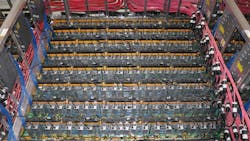Louisiana Cryptocurrency Mining site utilizing flexible-fuel Microturbines for On-Site Power Generation
A data center in Louisiana is renting a gas-fired microturbine to power work in blockchain and cryptocurrency mining.
Lone Star Power Solutions, the regional distributor for microturbine manufacturer Capstone Green Energy, has contracted with the remote data center crypto miners for a five-year rental of the Capston C1000S microturbine system. This is the data operation’s second deal for a C1000S with the first commissioned nearly five months ago.
The data center, which was not named by Lone Star or Capstone, reportedly sits on an oil and gas well. It handles a large volume of blockchain and cryptocurrency validation mining, which requires a tremendous amount of energy.
Capstone’s microturbines are fuel flexible, meaning that the system can use waste gas. The company has expanded its Energy as a Service (EaaS) business, helping customers avoid upfront costs to install microgrid-level solutions.
“The operational success of the first unit installed last October and its ability to operate on a wide variety of fuel sources was an integral part of our customer’s decision to add a second unit,” said Doug Demaret, President of Lone Star Power Solutions. “Capstone’s innovative products allow Lone Star Power Solutions to provide its customers with 100% uptime, extremely low emissions, and infrequent visits under the harshest conditions, allowing our customers to focus on their core business.”
According to a Cambridge University study, Bitcoin mining alone might use more energy than all of the refrigerators in the U.S. combined and would ranked 27th in energy demand globally if it was its own country.
See EnergyTech's full coverage of Microgrids in the C&I and Mission Critical Energy Transition
Cryptocurrency mining is the process by which new crypto “coins” are entered into circulation. Their production requires highly sophisticated computers, often in a data center, to solve complex computational math problems.
At a time when the utility grid is strained due to extreme weather, aging infrastructure, and inadequate transmission, on-site power provides a resilient alternative for energy-intensive facilities, Capstone noted.
Each of the Capstone C1000S microturbines has a generation rating of 1,000 kW (1 MW) and CHP efficiency of up to 90 percent. The net heat rate is about 10,300 British thermal units per kWh.
----
(Rod Walton, senior editor for EnergyTech, is a 14-year veteran of covering the energy industry both as a newspaper and trade journalist. He can reached at [email protected]).
About the Author
Rod Walton, EnergyTech Managing Editor
Managing Editor
For EnergyTech editorial inquiries, please contact Managing Editor Rod Walton at [email protected].
Rod Walton has spent 17 years covering the energy industry as a newspaper and trade journalist. He formerly was energy writer and business editor at the Tulsa World. Later, he spent six years covering the electricity power sector for Pennwell and Clarion Events. He joined Endeavor and EnergyTech in November 2021.
Walton earned his Bachelors degree in journalism from the University of Oklahoma. His career stops include the Moore American, Bartlesville Examiner-Enterprise, Wagoner Tribune and Tulsa World.
EnergyTech is focused on the mission critical and large-scale energy users and their sustainability and resiliency goals. These include the commercial and industrial sectors, as well as the military, universities, data centers and microgrids. The C&I sectors together account for close to 30 percent of greenhouse gas emissions in the U.S.
He was named Managing Editor for Microgrid Knowledge and EnergyTech starting July 1, 2023
Many large-scale energy users such as Fortune 500 companies, and mission-critical users such as military bases, universities, healthcare facilities, public safety and data centers, shifting their energy priorities to reach net-zero carbon goals within the coming decades. These include plans for renewable energy power purchase agreements, but also on-site resiliency projects such as microgrids, combined heat and power, rooftop solar, energy storage, digitalization and building efficiency upgrades.

